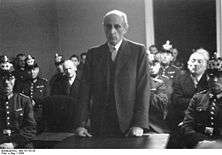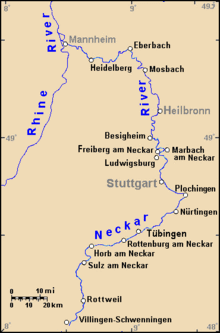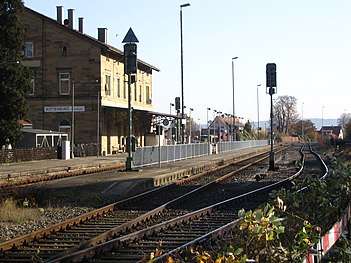Rottenburg am Neckar
![]()
Rottenburg am Neckar | |
|---|---|
 River Neckar in Rottenburg | |
 Coat of arms | |
Location of Rottenburg am Neckar 
| |
 Rottenburg am Neckar  Rottenburg am Neckar | |
| Coordinates: 48°28′38″N 08°56′04″E | |
| Country | Germany |
| State | Baden-Württemberg |
| Admin. region | Tübingen |
| District | Tübingen |
| Government | |
| • Lord Mayor | Stephan Neher (CDU) |
| Area | |
| • Total | 142.26 km2 (54.93 sq mi) |
| Elevation | 349 m (1,145 ft) |
| Population (2018-12-31)[1] | |
| • Total | 43,723 |
| • Density | 310/km2 (800/sq mi) |
| Time zone | CET/CEST (UTC+1/+2) |
| Postal codes | 72101–72108 |
| Dialling codes | 07472, 07478, 07457, 07073 |
| Vehicle registration | TÜ |
| Website | www |
Rottenburg is the seat of a Roman Catholic bishop, being the official centre of the diocese of Rottenburg-Stuttgart. Moreover, it has a college of church music and a university of applied sciences (German Fachhochschule), specialising in forestry.
Geography
Rottenburg is divided into a city core and seventeen (suburban) districts.
Suburban districts of Rottenburg: Bad Niedernau, Baisingen, Bieringen, Dettingen, Eckenweiler, Ergenzingen, Frommenhausen, Hailfingen, Hemmendorf, Kiebingen, Obernau, Oberndorf, Schwalldorf, Seebronn, Weiler, Wendelsheim and Wurmlingen.
History
Rottenburg was founded as a Roman town, Sumelocenna, probably around the year AD98, and was one of the most important Roman towns in the southwest of Germany. It had a line of walls built to defend it from the attacks of the Alamanni, who nevertheless destroyed it in 259-260.
The name Rottenburg is thought to derive from a Germanic root that is also present in the English word "rotten", in an older meaning of "destroyed". According to this hypothesis, the town would have received its name when, in the early Middle Ages, Alemannic people founded their settlement in the vicinity of the ruins of Roman Sumelocenna. An alternative etymology of Rottenburg as "red borough" is also considered possible, however.
In the Middle Ages, the town was first governed by the counts of Hohenberg, who, however, were forced to sell it to the Habsburg dynasty in 1381. Rottenburg remained a part of Further Austria until 1805, when it was assigned to Württemberg in the Peace of Pressburg.
Rottenburg became the seat of a Catholic bishop as late as 1821–1828, when, after the secularisation and the Napoleonic Wars, a reorganisation of Catholic life in southwest Germany had become necessary.[2] It was then decided not to choose the more important nearby places of Stuttgart or Tübingen as a diocesan town, as these were firmly Protestant.
Rottenburg is known among Anabaptists as the place of death for Michael Sattler, a former monk who was involved in missionary activities in the Rottenburg and Horb am Neckar region. Sattler was burned at the stake on "Gallows Hill" on 20 May 1527.
Main sights
Dom St. Martin has been the city's cathedral since 1821. Its tower, dating from 1486, is its most prominent feature.

Spanning various architectural periods, the Stiftskirche St. Moriz incorporates a Gothic core with elements from an earlier church and a later Baroque hall church. The Gothic feel is what persists, from 14th- and 15th-century frescoes on the pillars to the 15th-century painting of the Four Evangelists on the ceiling in the choir. In the north aisle stands an ornamented column depicting various princes, donated in 1470 by Archduchess Mechthild, the wife of Ludwig I and mother of Eberhard the Bearded. A copy also stands in the city's Marktplatz.
There are two museums in town, the Sülchgau Museum, specialising in pre- and early history and Roman influences on the area, and the diocesan museum, focusing on ecclesiastical art, painting and sculpture.
In nearby Weggental is the pilgrimage church of Wallfahrtskirche St. Maria, rebuilt in 1682–1695 in Baroque style, but containing a medieval pietà and a very fine rendition of the Virgin swooning during the Deposition of Christ from the cross.
A more modern landmark is the Eckenweiler Water Tower. Built of reinforced concrete in the 1970s, its unusual design, a cube supported by a rectangular column, is notable.
Sister city
Since 1979 Rottenburg's sister city is Saint Claude in France.
Personalities
Honorary citizens
The Town of Rottenburg am Neckar and respectively the former municipalities, which have been incorporated, have awarded the honorary citizenship to the following persons:
- Rottenburg
- 1901: Hermann Friedrich Wittich, Regierungsrat
- 1904: Gustav Holzherr, independent gentleman
- 1909: Karl Bitzenauer, parish priest of the town
- 1924: Paul Wilhelm von Keppler, Bishop of Rottenburg
- 1930: Karl Landsee, merchant
- 1931: Alois Kremmler, Oberstudiendirektor (principal)

- 1931: Eugen Bolz (1881–1945 (executed in Berlin-Plötzensee), politician and member of the resistance
- 1947: Joannes Baptista Sproll, Bishop of Rottenburg
- 1947: Max Kottmann, vicar general
- 1949: Josef Schneider, Mayor of Rottenburg and Kanzleidirektor (retired)
- 1958: Franz Anton Buhl, schoolmaster and local historian
- 1961: Josef Eberle, poet and publisher
- 1967: Alfred Planck, entrepreneur
- 1968: Carl Joseph Leiprecht, Bishop of Rottenburg
- 2003: Winfried Löffler, Lord Mayor of Rottenburg (retired)
- 2008: Walter Cardinal Kasper, former Bishop of Rottenburg-Stuttgart and present Cardinal of the Roman Curia
- 1891: Kilian von Steiner, banker
- 1919: Hieronymus Baur, Mayor of Ergenzingen (retired)
- 1961: Alfons Leykauf, parish priest
- 1965: Maximilian Schier, schoolmaster
- ?: Rudolf Franziskus de Paula Joseph Fidel Freiherr von Wagner, Warminister of Württemberg
- 1908: Ludwig Franz Freiherr von Wagner, Lieutenant General
- 1938: Karl Franz Ferdinand Viktor Osterwald, factory manager of the power station
- ?: Ignaz Kleiner, parish priest
- 1947: Otto Heine, parish priest
- 1905: Sebastian Bauer, dean
- 1953: Franz Josef Fischer, auxiliary bishop
- 1968: Stefan Kruschina, parish priest
Sons and daughters of the town
Prominent natives of Rottenburg:
- Meinrad von Einsiedeln (c. 797–861), hermit
- Albert II. von Hohenberg, (1303–1359), Bishop of Freising
- Franz Anton Hoffmeister (1754–1812), composer and music publisher

- Ottilie Wildermuth (1817–1877), author
- Theodor Schnell der Ältere (1836–1909), sculptor and church outfitter
- Eugen Bolz (1881–1945), politician (Zentrum) see: honorary citizens
- Josef Eberle (also known as Sebastian Blau, 1901–1986), publicist, poet and newspaper publisher (Stuttgarter Zeitung) see: honorary citizens
- Walter Bader (1901–1986), archaeologist and preservationist
- Ewald Bucher (1914–1991), politician (FDP/DVP), Member of the West German Parliament, West German Minister of Justice, West German Minister for regional planning, construction and urban development
- Dieter Planck (born 1944), president of the state office for preservation of historical monuments in Baden-Württemberg
- Winfried Hermann (born 1952), politician (Greens), since 2011 Minister for Transportation in Baden-Württemberg
- Knut Kircher (born 1969), former football referee

Gallery
 Railway station in Rottenburg
Railway station in Rottenburg- Eckenweiler water tower
 Gothic fountain
Gothic fountain- Episcopal Palace at the Eugen-Bolz-Square
References
- "Bevölkerung nach Nationalität und Geschlecht am 31. Dezember 2018". Statistisches Landesamt Baden-Württemberg (in German). July 2019.
- "Geschichte". drs.de. 2008-08-19. Archived from the original on 2011-02-17. Retrieved 2009-05-06.
External links
- Chisholm, Hugh, ed. (1911). . Encyclopædia Britannica. 23 (11th ed.). Cambridge University Press. pp. 765–766.
- Official website

- Various memorials in Rottenburg at the Sites of Memory page